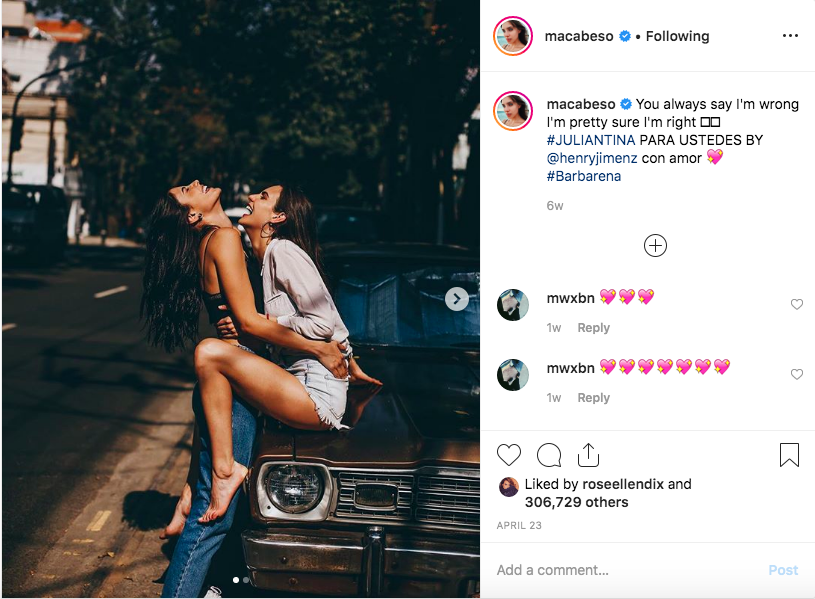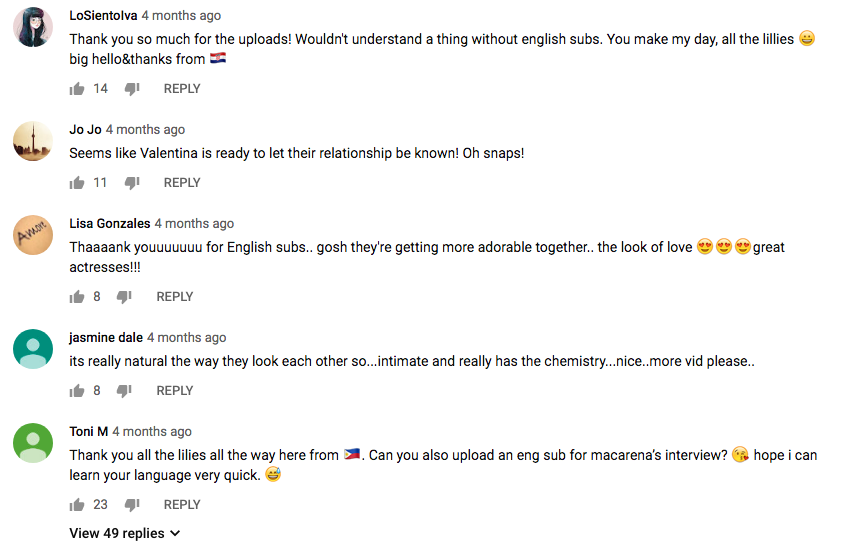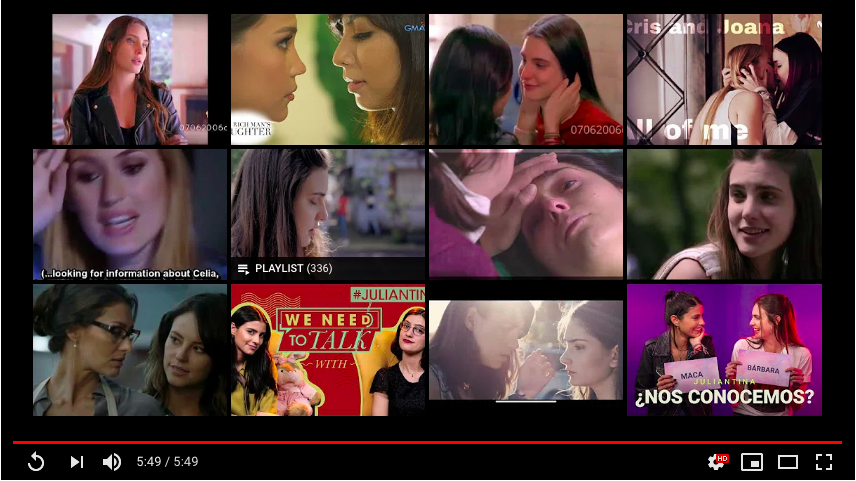The Kiss Heard ‘Round the World: “Juliantina” and International Lesbian Soap Opera Fandom
Kira Deshler / University of Texas at Austin

In the last decade or so, a peculiar phenomenon has begun to occur in certain corners of the internet. Soap operas, particularly of the Latin American variety, have slowly begun to feature more lesbian couples. There was “PepSi” from Los Hombres del Paco (Antena 3, 2005-2010), “Jemma” from Hand aufs Herz (sixx, 2010-2011), Kate and Rana from Coronation Street (ITV, 1960-), “Clarina” from Em Família (Rede Globo, 2014), “Flozmín” from Las Estrellas (Channel 13, 2017-2018), and most recently, “Juliantina” from Amar a Muerte (Univision, 2018-). Suddenly, it seemed, with the advent of YouTube and Dailymotion, fans from around the world were able to engage with these relationships without having access to the full series themselves. Hundreds of videos of these couples, completely detached (through editing) from the context in which they originally aired, were uploaded to video sharing sites, and an international lesbian soap opera fandom was built. These videos, what Stephanie M. Yeung has called “fugitive representations” [1] because of the ways in which they are queerly archived and consumed, has continued to proliferate on YouTube and on other video sharing platforms, as more queer women discover and become invested in these relationships. The most recent, and arguably the most popular of these couples, is Juliantina.

Juliantina—a portmanteau of Valentina and Juliana, the two character’s names—is a relationship that exists on the telenovela Amar a Muerte. The series aired both on American Spanish-language network Univision and Mexican network Las Estrellas. Amar a Muerte follows a typically complex telenovela storyline centering on the deaths and reincarnations of Valentina and Juliana’s respective fathers. This central storyline, however, is only peripheral to Juliantina fans, who are focused exclusively on their love story. Most of this content is archived on YouTube. The most popular Juliantina channels have posted between 270 and 336 videos of the couple. These videos are between one and fiveminutes long (though usually closer to one), and span their entire relationship, from their first meeting to the conclusion of the series. Juliantina’s popularity has expanded further than the usual niche existence of these fugitive representations, with several famous lesbian YouTubers posting reaction videos, and popular queer websites, such as Autostraddle posting articles about the couple. The two actresses who portray Juliantina, Macarena Achaga and Bárbara López, even commissioned a special Juliantina photoshoot for their fans. (It is likely that López and Achaga’s enthusiastic engagement with fans has contributed to the overall popularity of the pairing). In addition, because viewers were so enamored with the couple, one fan created a fake Juliantina Netflix movie trailer, and another created and circulated a petition to make a Juliantina spin-off.

Juliantina’s popularity and the fan practices that comprise its fandom illustrate several unique factors that are central to the maintenance and production of queer female fandom online. One of the most intriguing aspects of Juliantina, and of all these soap opera lesbians, is the way that most viewers consume this content. As I mentioned above, the videos that are uploaded to YouTube and other social media sites are edited in such a way that the narrative only focuses on the lesbian relationships, while other storylines become peripheral or even nonexistent. Yeung calls this process “queer cutting” and suggests that “these capabilities [online streaming] are also allowing fans to rescue and preserve generative and meaningful lesbian representations whose value is further discounted within an already disparaged form.” [2] This process of queer cutting complicates normative understandings of television viewership, as Juliantina fans are only interested in one storyline within the series, rather than the series as a whole. The Juliantina videos are edited in such a way as to include only scenes that involve either Valentina or Juliana (or both), so that viewers can follow the Juliantina storyline in its entirety. Understandably, viewers who only watch the Juliantina videos are often confused about the other narratives within the show (namely the reincarnation storyline), and in this case the comments section acts as a space where fans can ask questions and receive answers from more knowledgeable viewers. YouTube then acts as an archive for this queerly-constructed content, which in turn provides a space for this fandom to coalesce. However, this archive is tenuous, as videos are often flagged for copyright by the networks, which leads to them being blocked in some countries. Fans often combat this problem by making the videos as short as possible or uploading them to Dailymotion, Facebook, or Dropbox instead, where copyright issues are less of a concern.
In addition to this particular style of editing, every Juliantina video is also translated into English by the Latin American fans who upload these videos. (The identities of these video creators remain unknown to most, as they are often only known by their usernames). This extensive fan labor allows for the existence of an international fandom surrounding these representations, with fans often expressing their gratitude for the video creators in the comments section as they wait for the next batch to be uploaded. (See more on translation in footnote below). [3] The international reach of this fandom is made visible in the comments sections of these videos, with viewers often revealing their location through comments such as “Thank you from Thailand!” or “Watching from Germany!” Though all fandoms are now more international than ever, the international scope of the Juliantina fandom is significant in that it makes visible the labor that is involved in maintaining this fandom. Additionally, the global flow of Juliantina content is unique, as much (though not all) of queer media that is celebrated and viewed globally is American or English-language content. Furthermore, the international popularity of Juliantina and other similar couples indicates the continued lack of affirming portrayals of queer women on a global level, as well as the almost indescribable draw these couples have for fans across borders and across language.

While soaps and/or telenovelas like Amar a Muerte are often perceived as unrealistic because of their reliance on melodrama, the international popularity of Juliantina with audiences who may not normally watch telenovelas indicates that it is the content rather than the form that draws viewers to the couple. Despite the connotation of soaps as frivolous, many Juliantina fans describe their investment in the couple as predicated upon the perceived “realness” of the relationship. I don’t mean real in the sense of “existing in the non-televisual world,” but rather real for the viewer in the sense of relatability (I have felt/experienced those feelings) or aspirationality (I haven’t experienced that, but I would like to someday). Ien Ang describes this structure of feeling as “emotional realism.” [4] It is queer fans’ investment in this emotional realism that produces their enjoyment of these fugitive representations, regardless of the national or generic context in which they exist, and it is sites like YouTube that allow these representations to proliferate on an international level.

Though I have focused this article on Juliantina specifically, as I outlined above, there are a number of soaps from around the world that have engendered similar fan practices. These soaps, and the lesbian relationships therein, are part of what we might call the canon of queer female media. As Yeung points out, YouTube, as the disseminator of much of this content, acts as an archive for this canon, and connects these texts to one another through its algorithmic functions. [5] YouTube’s algorithm, as well as the cultural knowledge of fans, allows for and encourages fans of one pairing to become invested in another, as fans who watch these queer soaps are pointed towards similar content hosted on the platform. These fugitive fan practices illustrate what Susan Driver calls the “queer possibilities of cultural literacy” [6], wherein the meaning of a text is decoded according to its queer resonances rather than its narrative cohesion. This canon is rarely made visible to those outside the queer female community, as this niche content remains only peripheral to the broader public, despite these couples’ centrality among queer viewers.

The fan practices that define the Juliantina fandom illustrate the unique ways in which queer female fans create and consume content, engaging with media in a manner that circumvents problems of access. [7] As Kelsey Cameron puts it, the models of fandom that pioneering fan studies scholar Henry Jenkins often engages with, models that center the practices of white men and are generally divorced from identity work, “do not necessarily translate to queer women, who lack both identity reinforcement from mainstream culture, which Jenkins’s subjects constantly receive, and the embodied sexual spaces that many position as key to the cultural lives of gay men.” [8] Indeed, the global reach of Juliantina and the fan labor and viewing practices that define its fandom demonstrate the continued marginality of queer women on screen, and, subsequently, the lengths fans must go to in order to preserve and centralize these stories.
Image Credits:
1. Juliantina’s first kiss.
2. Flozmín video on Dailymotion. Author’s screenshot.
3. Achaga’s Instagram post. Author’s screenshot.
4. Fan-made Juliantina Netflix trailer.
5. A portion of the comments section from a Juliantina video. Author’s screenshot.
6. YouTube suggestions. Author’s screenshot.
7. Image from a Juliantina video. Author’s screenshot.
- Yeung, Stephanie M. 2014. “YouTube as De Facto Lesbian Archive: Global Fandom, Online Viewership and Vulnerability.” Spectator, Vol 34.2 (Fall), p. 43. https://cinema.usc.edu/spectator/34.2/6_Yeung.pdf [↩]
- Yeung, p. 44. [↩]
- While many of these videos are from telenovelas and thus translated from Spanish (or Portuguese) to English, there are some videos of pairings from English-language series, such as Kate and Rana from Coronation Street, that are translated into other languages (most commonly Spanish). There is even one channel that, with the help of several international fans, has uploaded every Kate and Rana video with English, Spanish, Portuguese, and Arabic subtitles! https://www.youtube.com/playlist?list=PLB5tqINJWAWtNSwoLC4REi5NvyqBphdNJ. [↩]
- Storey, John. “Gender and sexuality,” Cultural Theory and Popular Culture, Routledge, 2015, p. 153. [↩]
- Yeung, p. 46. [↩]
- Driver, Susan. Queer Girls and Popular Culture: Reading, Resisting, and Creating Media. New York: New York: Peter Lang, 2007. p. 13. [↩]
- This circumvention however, also creates an ambivalent relationship between Juliantina fans and the Amar a Muerte producers, as Juliantina fans often do not consume the series in ways that are directly economically beneficial to the network. [↩]
- Cameron, Kelsey. “Constructing Queer Female Cyberspace: The L Word Fandom and Autostraddle.com.” Transformative Works and Culture, Vol. 24, June. 15, 2017. p. 1.6. DOI: https://doi.org/10.3983/twc.2017.0846. [↩]
Gracias por realizar este hermoso texto. 🇲🇽
Amazing analysis of how wlw fandom navigates media!! It’s something I’ve thought about immensely, as someone who helped with translations early on in the airing of Amar A Muerte. It was my first time doing so for any pairing, and I realized the amount of labor fans actually put in for wlw-specific content to have the reach it has, especially with Juliantina reaching the global level that it has. A lot of time and effort has gone into creating this Underground Railroad of queer content for women. I think it’s a beautiful thing that makes us as fans feel involved, and more visible and feel a sense of community and connection with other people who are around the world searching for the same thing (quality representation). For us Juliantina fans, the effort has culminated into plans for a film and a series centered on the couple in the near future, and ultimately it all just feels like a triumph. The need for this rep and our existence as an audience is slowly but surely being noticed.
Excelente :) 🇪🇨
Gracias por la dedicación! Fue muy interesante. 🇵🇪
Gracias por el artículo, Juliantina es una gran representación y esta abriendo millones de puertas. 😍🇦🇲
Thank you for reading!
Thank you!
Gracias :)
Thanks so much for reading and for the comment!
Denada!